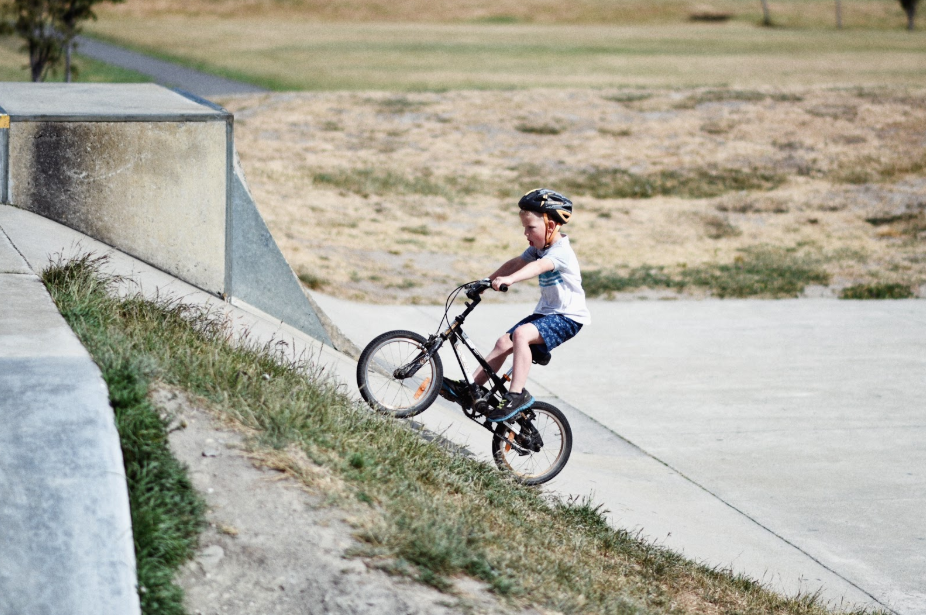This is a sponsored guest post.
Bicycle riding is one of the most popular pastimes among kids. It is fun, healthy, and a great way to interact with the outdoors or even commute to school and around the neighborhood. Unfortunately, it comes with its fair share of risks, especially when there is no one around to monitor them enjoying themselves.

Take your eye off your cycling child for just a minute, and it could potentially result in a fall, collision, or an accident in the worst case scenario. It is imperative that you take all measures to ensure that your young one is cushioned against any uncertainties that may arise when riding outside.
So what can you do to ensure your child’s safety on their bike once they develop the confidence to ride on the roads?
What should your child wear when riding?
Bicycle safety starts with the kind of gear your child has on when they venture outside for a ride. This will include clothes, as well as other safety accessories such as helmets. Wearing bright clothes and having reflectors on the bike can help to keep your child safe on the road.
It makes them more visible to motorists and other road users, reducing the chances of getting run over. You want to ensure that nothing gets caught in the chain, wheel spokes, and other rotating parts. So loose pants, shoelaces, backpack straps, etc are dangers to always watch out for before you bid your child goodbye.
Never allow them to go riding barefoot. Bicycle helmets are another crucial safety accessory that your loved one requires when cycling. In case of a fall or collision, it protects the cyclist against brain, head, and facial injuries and can reduce the extent of head injury by sixty to ninety percent. Before buying a bicycle helmet for your kid, make sure that it is:
• Approved- The helmet has to be approved by the concerned road safety authorities and meet the set standards.
• The right size and fit- For the helmet to perform its work, it should be just the right fit for your child. It should be comfortable; not too tight fitting or loose. Choose a helmet that offers good ventilation and isn’t too heavy.
• In the right condition- Helmets are designed to protect the rider for a single impact only. So, if the helmet has been dropped or involved in an accident, it may not be the right choice; especially if the inner foam has been punctured. This should discourage you from buying second-hand.
Other safety gears include things like knee and elbow pads, as well as mouth guards for little kids who are still working on their balance.
How can you keep your child safe in traffic?
Safety on the road is best taught in the actual traffic environment. Children primarily learn by experience and adult interaction is an effective way of helping them acquire this essential skill. But before you take your little boy out on a busy road, you might want to talk to them about general traffic rules, road sign interpretation, and where it is most safe to ride.
Allow them to practice regularly on footpaths, and teach them how to ride in a straight line, braking properly, as well as turning corners cautiously. This will get them used to the traffic environment and gives them the confidence to have full control on the road. You also want to inform them about the importance of using a bell, headlight, and indicating before turning corners. More on best bike bell can be learned here.
How do you choose the right bike for your child?
The bicycle your kid is riding has to be the right fit for his young body size, and this plays a huge role in safe cycling. A bicycle that is too small or too big is risky because it takes away from the level of control and handling. You can ensure this is not the case by testing for size before buying it .
Make your child stand over the bike with both his feet on the ground. Ideally, for lightweight or medium bicycles, there should be a 2cm allowance, at least, between the crossbar and his crotch. For mountain bikes or BMXs, you should have at least 5cm between the crossbar and his crotch.
Also, be sure that all the controls are within fast reach and comfortable to use. An adjustable seat will be helpful and if you are buying a used bike, get it serviced thoroughly.
How should you care for your child’s bike?
It is crucial to ensure that your kid’s bike is always properly maintained. Make a point to regularly checking the wheels, pedals, brakes, chains, bearings, etc to confirm that they are in an efficient working condition. The tires should have the right air pressure and the gears, nuts, and bolts should be tightly screwed. Be sure to lubricate all the moving parts on the bike to reduce the action of friction.



